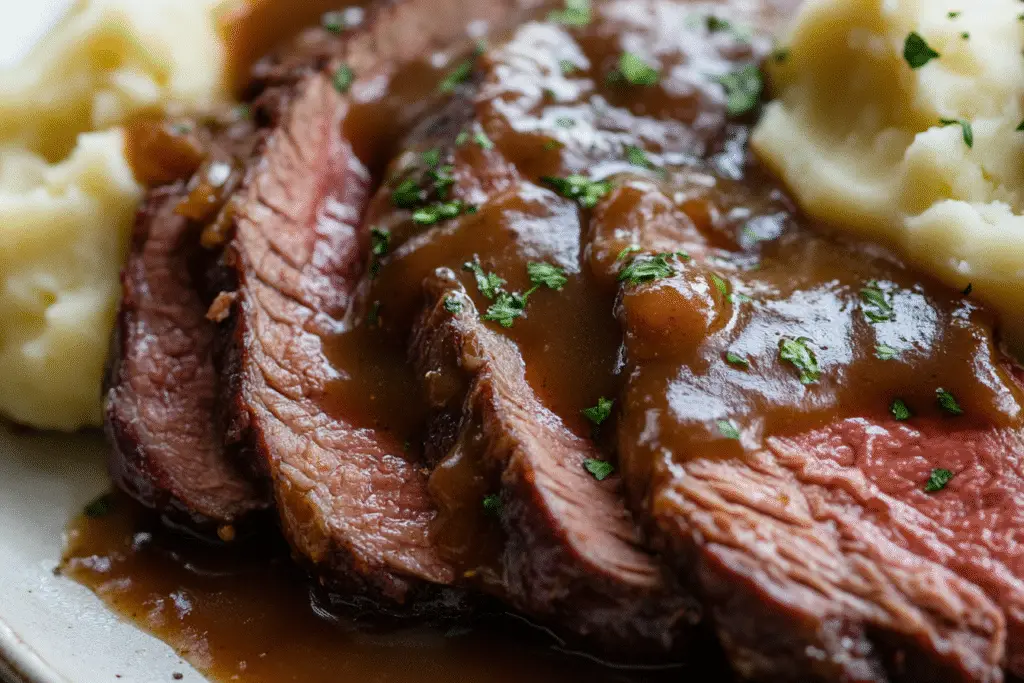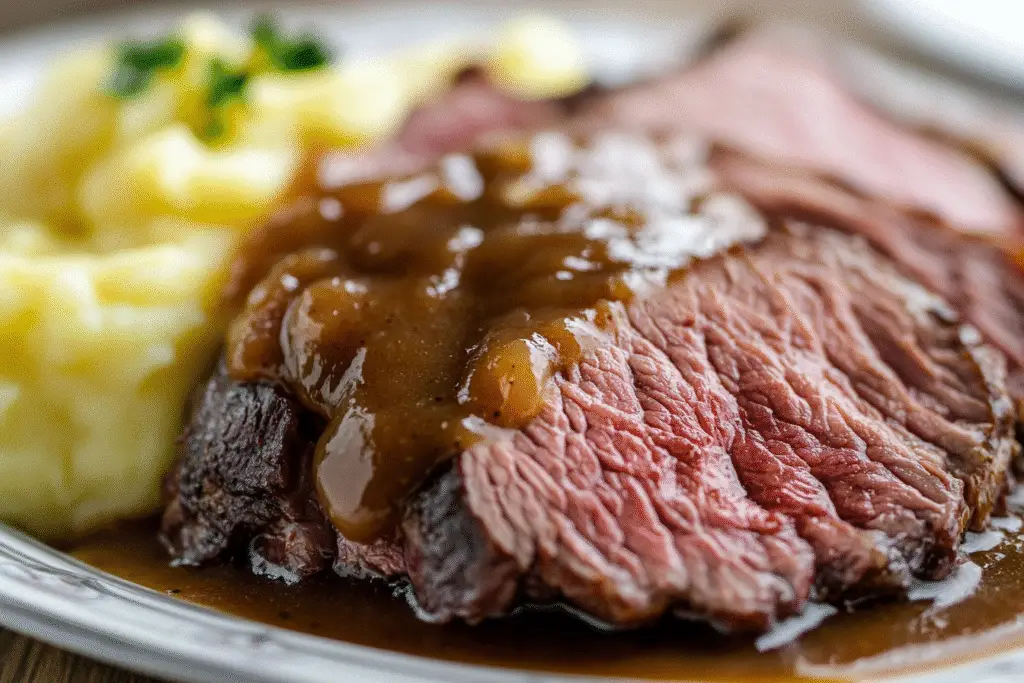There are few meals as iconic and comforting as roast beef with gravy. It’s the kind of dish that evokes family dinners, holiday feasts, and Sunday suppers that linger for hours. Perfectly roasted beef—juicy and pink in the center, deeply flavorful, and surrounded by a rich, savory gravy—strikes the perfect balance between rustic tradition and elegant simplicity.
This recipe walks you through making a classic roast beef using a reliable oven-roasting method that delivers a tender, evenly cooked roast every time. The gravy is made from the pan drippings, enhanced with beef broth, aromatics, and just the right thickener for a smooth, luscious sauce. We’ll cover the best cuts to use, how to get that perfect crust without drying out the inside, and tricks for gravy that’s never lumpy or bland.
Whether you’re preparing a holiday centerpiece or a cozy weeknight dinner, this roast beef with gravy will leave your kitchen smelling amazing—and your guests reaching for seconds.
Why This Roast Beef Recipe Works
Roast beef might sound intimidating, but with the right cut and technique, it’s surprisingly straightforward. This recipe focuses on:
- Simplicity: No fuss, no complicated steps. Just season, sear, roast, rest, and carve.
- Flavor: A simple seasoning blend brings out the natural richness of the beef, while the gravy amplifies the umami.
- Moisture: A hot oven at the start helps build a crust; a lower temp finish ensures juicy meat throughout.
- Gravy magic: By deglazing the roasting pan, you unlock deep, roasted flavors that can’t be faked.
With detailed instructions and tips, you’ll feel confident even if it’s your first time roasting beef.

Choosing the Right Cut of Beef
The key to great roast beef is selecting the right cut for your needs—tender enough to roast but flavorful enough to stand on its own.
Best Cuts for Roast Beef:
- Top sirloin roast: Lean, flavorful, and budget-friendly. A great all-purpose roast.
- Eye of round: Very lean and affordable, but can be tougher—needs careful slicing and gravy.
- Chuck roast: More marbled and tender, ideal for low-and-slow cooking or pot roast.
- Ribeye or prime rib roast: Rich and tender, but more expensive—great for holidays.
- Bottom round roast: Slightly tougher but deeply beefy when sliced thin and served with gravy.
This recipe uses a top sirloin roast, but you can substitute with any of the above, adjusting cook time as needed.
Equipment You’ll Need
- Roasting pan or oven-safe skillet with rack
- Meat thermometer (instant-read or probe-style)
- Tongs
- Saucepan (for making gravy)
- Carving knife and cutting board
- Aluminum foil (for resting)
Optional but helpful: fat separator for the pan drippings, sieve for straining gravy.

Flavor Boosters and Add-Ins
While salt, pepper, and garlic are enough for a traditional roast, here are some additions if you want to deepen the flavor:
- Fresh herbs: Rosemary, thyme, or sage tied in a bundle and placed in the pan.
- Mustard rub: Combine Dijon mustard with olive oil and garlic for a tangy crust.
- Worcestershire sauce: Add a splash to the gravy for extra umami.
- Red wine: Deglaze the pan with a few tablespoons for a richer gravy.
For the gravy, a touch of soy sauce, balsamic vinegar, or beef bouillon paste can really round things out without overpowering.
Ingredients
For the Roast Beef:
- 3 lb top sirloin roast (or preferred cut)
- 2 tablespoons olive oil
- 1½ teaspoons kosher salt
- 1 teaspoon black pepper
- 1 teaspoon garlic powder
- ½ teaspoon onion powder
- Optional: 1 tablespoon fresh chopped rosemary or thyme
For the Gravy:
- 2 tablespoons beef drippings or butter
- 2 tablespoons all-purpose flour
- 2 cups beef broth (preferably low sodium)
- 1 teaspoon Worcestershire sauce (optional)
- Salt and pepper to taste
Step-by-Step Instructions
Step 1: Bring the Beef to Room Temperature
Remove the roast from the fridge 1 hour before cooking. Pat dry with paper towels.
Rub all over with olive oil, salt, pepper, garlic powder, and onion powder. Add chopped herbs if using. Let it sit uncovered at room temperature—this helps ensure even cooking.
Step 2: Sear the Roast (Optional but Recommended)
Preheat the oven to 450°F (232°C).
Heat a cast iron skillet or large oven-safe pan over high heat. Add a little oil, then sear the roast for 2–3 minutes per side until browned all over.
Place the roast on a rack in a roasting pan, fat side up. Insert a meat thermometer into the thickest part.
Step 3: Roast the Beef
Transfer to the oven and roast at 450°F for 15 minutes.
Reduce the temperature to 325°F (163°C) and continue roasting for 45–75 minutes, depending on size and desired doneness.
Internal Temperature Guide:
- Rare: 120–125°F
- Medium-rare: 130–135°F (recommended)
- Medium: 140–145°F
Remove from the oven when it’s 5°F below your target temp. It will continue cooking as it rests.
Tent loosely with foil and rest for 20–30 minutes before slicing.
Making the Gravy
Step 4: Deglaze and Make a Roux
While the roast rests, make the gravy.
If your pan has drippings, pour them into a bowl or fat separator. Skim off excess fat and reserve 2 tablespoons.
Heat the drippings or butter in a saucepan over medium heat. Whisk in flour and cook for 1–2 minutes, stirring constantly, until golden brown (this is your roux).
Step 5: Add Broth and Simmer
Gradually whisk in beef broth and Worcestershire sauce (if using). Bring to a simmer.
Whisk constantly for 4–5 minutes, or until thickened. Season with salt and pepper to taste.
Optional: Strain the gravy through a sieve for an ultra-smooth texture.
Step 6: Slice and Serve
Slice the roast against the grain into thin slices using a sharp carving knife.
Arrange on a platter and drizzle with warm gravy. Serve the remaining gravy on the side.
Troubleshooting Tips
- Meat too tough? It may be undercooked or cut with the grain. Always rest the meat and slice thinly against the grain.
- Dry roast? Ensure you’re not overcooking, and consider basting during roasting if using a lean cut.
- Gravy too thin? Simmer longer to reduce. Or mix 1 tsp cornstarch with 2 tsp cold water and whisk in.
- Gravy too salty? Add unsalted broth or a splash of cream to mellow it out.
Storage and Make-Ahead Tips
To Store: Refrigerate sliced beef and gravy in separate airtight containers for up to 4 days.
To Freeze: Roast beef freezes well. Wrap slices tightly and freeze for up to 3 months. Thaw in the fridge and reheat gently with a bit of broth.
To Reheat: Warm beef slices gently in a covered pan with a splash of broth or water to keep moist. Reheat gravy over low heat, whisking until smooth.
What to Serve with Roast Beef and Gravy
This hearty main dish deserves equally comforting sides. Try it with:
- Mashed potatoes or roasted garlic mash
- Yorkshire pudding or warm dinner rolls
- Roasted carrots, green beans, or Brussels sprouts
- Creamed spinach or sautéed kale
- Horseradish sauce for a zesty kick
It also makes amazing leftovers: sandwiches, roast beef hash, grain bowls, or steak-style salads.
Roast Beef vs. Prime Rib vs. Pot Roast
- Roast beef: Leaner cut, oven-roasted, typically served sliced with gravy.
- Prime rib: Rich, marbled rib roast often reserved for special occasions.
- Pot roast: Braised in liquid, resulting in a shreddable, stew-like texture.
Roast beef with gravy sits right in the middle—more refined than a stew, but not as indulgent as prime rib. It’s practical, elegant, and always a crowd-pleaser.
When done right, roast beef with gravy is the kind of meal that brings people to the table—and keeps them there. It’s hearty, classic, and deeply satisfying, with just enough elegance to serve on special occasions but simple enough to make on a regular weeknight.
